I hit a weird spot recently where I just hadn't actually been playing ZZT games aside from the regular streams. So I figured I would treat myself to get back into the swing of things, and did my usual strategy of mashing Roulette without managing to find anything that really sparked joy. Taking a different approach, I instead started browsing ZZT games by release year, looking for something in the early-2000s as the Museum Statistics article enlightened me to the fact that actually I really like this era of ZZT games. The community might have been getting more mean-spirited, but that wasn't really reflected in most releases.
I had my moment of serendipity when I reached Eurakarte's Year of Shapiro. Over on the Discord dave2 had recently asked me if I had done anything with the Shapiro series. I told him I played the first Shapiro, Mr. Shapiro Cares Not For Lies back in 2018 and enjoyed it, and that I should check out some of Karte's other games. At that point, Year of Shapiro seemed fated to be the next game covered.
And good for it! Lies was pretty fun and all, but Year of Shapiro, Karte's collection of unreleased Shapiro projects and actually released 24 Hours of ZZT games is an excellent collection. The core games included made me realize that Eurakarte's capabilities with ZZT, were apparently overlooked. This collection has some great engines that left me in confusion as to why Karte wasn't among names like Janson, Commodore, and Quantum when it came to dazzling code.
And, the biggest surprise of all, these more than two decade old games that feature of a lot of "random" humor, are genuinely funny. Basically any game that had dialog in it, had me laughing at some point.
Let us then see what Eurakarte was up to that went tragically overlooked in this grab bag assortment starring America's favorite yellow triangle.
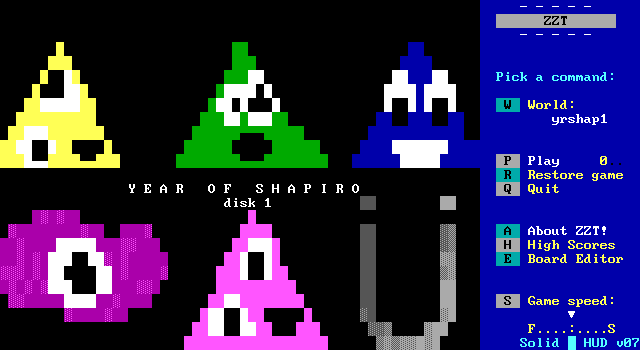
Triangle Man Hates Umlaut Man
Eurakarte assumes that by this point, if you're playing Year of Shapiro, you're familiar with who that character is. For newcomers, here's a quick glance at Shapiro's crew. It's a bunch of goofball triangles, a blob, a Ü character, and apparently Zenith Nadir.

Mr. Shapiro - The hero and leader of the group. Very opinionated. Whatever it is, Shapiro will either care for or care not for it.

Triangy - Shapiro's good friend, who is afraid of everything. He screams pretty much constantly. Sometimes over sensible things to be afraid of, but usually not.

Ibo - Somewhat of a businessman character that seeks wealth. Has a verbal-Ibo tic-Ibo where he says his name after most words. Gets to bounce off Shapiro with his own inane ideas.

Rob Blob - An amorphous friend! Mostly restates the obvious. Has a dapper personality, saying things like "Quite right!" and "Indeed!" a bunch. Probably the closest thing to the straight man among the group of regular geometry with irregular personalities.

Shapiroette - Girl. Shapiro's love interest perhaps? She's written purposely leaning into the tropeyness of a damsel in distress, where the lack of a personality is supposed to be amusing rather than an oversight. She doesn't lean into too hard though, so now the character feels kind of weird. The sort of thing where you get to say "No, no, it's ironic you see." but so much time has passed there's a lingering doubt. Even at her most stereotypical, she's never painted as annoying, useless, or existing solely to give Shapiro a potential romantic partner.

Dr. Kabadbot - The villain who plans to take over the world, kidnaps Shapiroette all the time, and is regularly foiled by Mr. Shapiro and his friends. A bit Dr. Robotnik both in terms of "bot" and in his technological prowess. Not very menacing despite his best efforts.
Zenith - The actual ZZTer Zenith Nadir. He doesn't appear in any of the comics that I've seen, yet he seems to show up in a number of Shapiro games not as a cameo off to the side, but front and center with the rest of the cast. Karte doesn't give him too many lines, but the essence is captured for sure.
Mr. Shapiro isn't merely a ZZT protagonist. Eurakarte also produced a webcomic, most of which is lost to time save for a few that were bundled with ZZT releases.
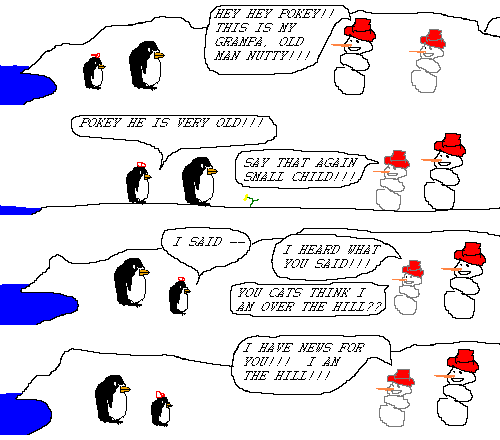
If you're at all familiar with the early webcomic Pokey The Penguin, then Shapiro's visuals and tone will feel very familiar. You'd be forgiven if at first glance your assessment of Shapiro was that it was Eurakarte ripping off an early Internet icon and calling it his own. That's selling Shapiro a bit short, Eurakarte definitely tries and succeeds at making these characters and their adventures go beyond "legally distinct" Pokey..
The games though, are where Eurakarte's creativity allows Shapiro to truly becomes its own thing. While the mannerisms of the characters are still reminiscent of Pokey and his pals in the arctic circle, as ZZT games Eurakarte produced a good number of adventures that let the characters establish themselves. The cast and their humor is backed up by an impressive variety of gameplay styles, ranging from typical ZZT journeys, to platformers, to RPGs, to arcade games.
The Mr. Shapiro franchise (if you will) made a lasting impression on ZZTer culture of the era. "Foo cares not for thing" was a common enough phrase, and anyone that immersed themselves in the Shapiro series will undoubted carry "It's tasty cuz it's blue" with them to the grave. Heck, I recently had to dig through some 2004-era IRC logs to see if I could find the ZZT community reacting to Cave Story, only to witness myself describing Balrog as seeming straight of Shapiro. ZZT has only a handful of iconic characters, and of them, Mr. Shapiro may very well be one of the most recognizable to anyone around in the early 2000s.
Collect Them All!

With nine games to play in one package (eight really), Eurakarte gives players quite a lot to keep themselves busy with. The games are split between two worlds of considerable size. The first is focused primarily around scrapped sequels, a lone fan submission to the pack, and one brief mini-game made by Eurakarte so that the compilation would have something created just for it. File two is mostly focused on two Mr. Shapiro games created for 24 Hours of ZZT contests, with one more abandoned sequel and a rather impressive platforming engine based game.
This is one of those worlds where I can conveniently just go through it game by game for the most part. Eurakarte arranged everything in a sensible enough order, and the various abandoned projects all have enough depth to them that they're worth focusing on individually. Good job Eurakarte.
Mr. Shapiro Cares Not For Mountains / Mr. Shapiro Cares Not For Forests
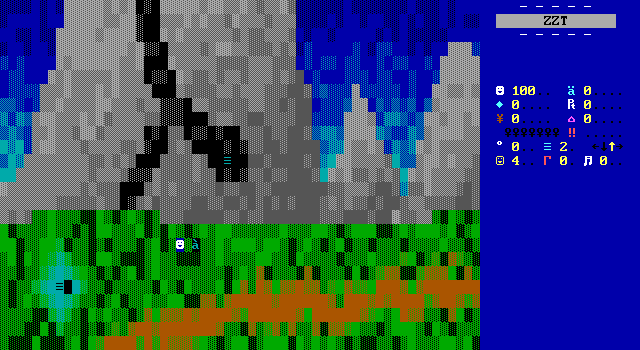
These first two Shapiro games are both from a scrapped Mr. Shapiro Cares Not For Lies 2, with Shapiro and the rest of the gang traveling to various locations for no explicitly stated reason, and grabbing a magic gem found at the end of each. Presumably a full game would have come up with some better justification for these trips, and in fact a later game not connected with these first two, uses a similar premise with more than a magic gem at the end that better explains why Shapiro would come to such a place.
Each game is accompanied by a very brief paragraph of commentary from Eurakarte on the main menu. Here Karte specifically compares the game to Asbestos, a game I streamed some years ago now and remember being a fairly dull exploratory game with players hopping from planet to planet. Compared to Asbestos (with a capital A), Shapiro is the clear winner. The worlds presented here do a much better job of keeping players engaged than the awkward roaming of an empty desert that I remember from Asbestos. I, however, am a dummy who immediately forgot that the game specifically cited its influence on the menu. So for me, the immediate parallel was Tseng's Gem Hunter 3. Either way, you get non-linear adventure hopping between planets/dimensions solving puzzles and fighting enemies in order to reach the exit. Rinse and repeat.
With Gem Hunter 3, I found most of the stages to be mediocre or worse, with little for players to do while not looking for obtusely hidden gems, and lamented that the party would always split up, preventing them from interacting with one another. Still better than I remember Asbestos being, and still falling short of Shapiro.
Eurakarte shows us here what Gem Hunter 3 and Asbestos wish they had been. Thanks to Shapiro traveling with his full crew and not splitting up the moment a location is entered, there are ample opportunities for dialog whenever players discover something. Shapiro's humor is the cornerstone on which all Shapiro adventures are built, and so Eurakarte realizes the importance of not just having Mr. Shapiro mumble to himself when he finds a strange machine or uncovers a grisly murder.
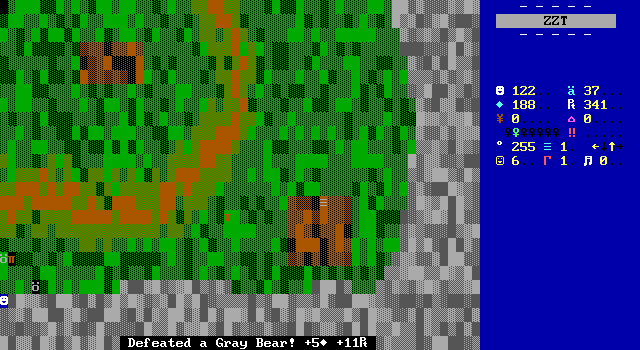
In addition, Mountains and Forest are full of enemies to deal with. The action comes in two flavors. Classic, in which enemies make their way towards Shapiro with players blasting away to keep him safe. The other, is the seemingly obligatory RPG engine. These usually wear out their welcome these days within, I don't know, three turns? Four if you're lucky? Yet Eurakarte does a phenomenal job with them. The game uses the less often seen pop-up RPG style where rather than have a dedicated board for each fight, the code is self contained on the board and played via ZZT's message windows with hyperlinks to choose tactics.
The RPG engine here is so impressive, that it genuinely deserves a section on its own, and shall receive one eventually. It truly is something that could have carried an entire game easily with an astonishing number of choices for players to make, without it turning into a case of "spam this attack because it's consistent" as many ZZT RPGs do.
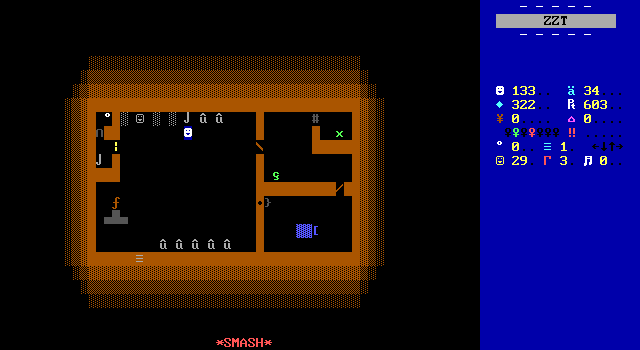
When Karte isn't threatening the player's health, he's instead decorating the environment with unique puzzles and unusual obstacles such as a single rope blocking a doorway which give players reason to explore their surroundings in detail, and let the game's cast get to bounce off one another. Since these characters are meant to be so silly, the obstacle that doesn't seem particularly difficult to navigate lends to the game's humor, with Karte having fun himself in the way he implements solutions for these unusual problems.
Eurakarte also does a fantastic job of playing with players' expectations during these puzzles, encouraging players to embrace the cartoon logic without asking them to do anything so wild that they wouldn't have ever thought to try it. One building has a large pit in the floor that can't be crossed. The solution is to grab a carpet from another room and cover the pit, allowing for safe passage. Does it make sense in general? Of course not! Does it make sense for the triangle who owns a flying jeep? One hundred percent.
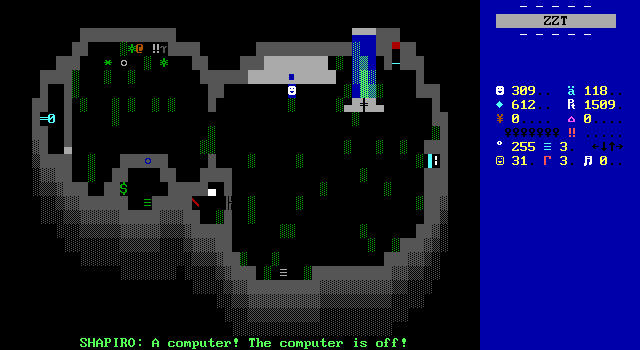
And even if you're not convinced, Karte's puzzles are localized. You don't run across the pit on one screen and have to think to grab the carpet you passed six boards away. Everything you need to get past an obstacle can be found on the same board. This drastically limits the search space, preventing unneeded backtracking and frustration if your hunch happens to be incorrect. When it takes all of five seconds to get from one corner of the board to the opposite, it's hard to get annoyed at cartoon logic being a component of puzzle solving. You're already almost there as soon as you even realize there's an obstacle to bypass.
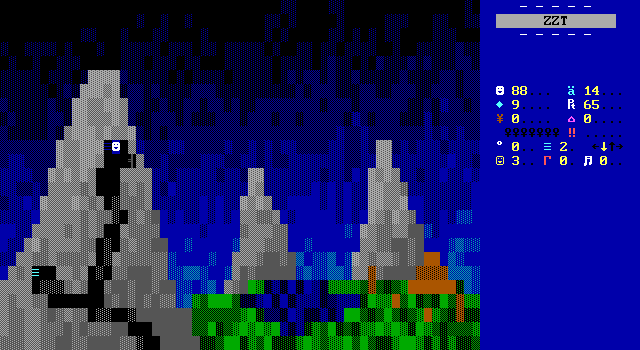
All of this helps to make the two games (or one, I cannot decide how to count them,) simply good. I wish the story was established in any way between the two. Forests has Shapiro exploring a cave and forest where there's not a single NPC to speak to aside from his fellow party members. Mountains hints at a bit more, with an ancient city being discovered and two priests of an unknown religion recognizing Shapiro and decreeing that he must die with no explanation as to why or how they know who he is. There's definitely some opportunity for story in these two chapters, though depending on what Eurakarte specifically had in mind for the game's structure, there's no reason that the exposition couldn't have come between chapters or even be added in later. What's here may be light on story, yet the joy of exploration itself as well as the RPG combat elevate it something I do wish there was more of, which is more than I can say of Asbestos and Gem Hunter 3.
To be fair to Vampy and Tseng however, for Year of Shapiro Eurakarte had the complete series for both those other open-ended adventures available to reference before even the first Shapiro game was ever released, giving him ample time to figure out what worked about them and how to avoid what didn't. Tseng and Vampy also both finished their respective games, flawed as they may have been. Eurakarte meanwhile was stuck sitting on this incomplete project that got shoved out the door only thanks to this collection. Whether the complete game would have maintained this level of quality is impossible to say, and it's not exactly fair to compare a hypothetical game to a finished one.
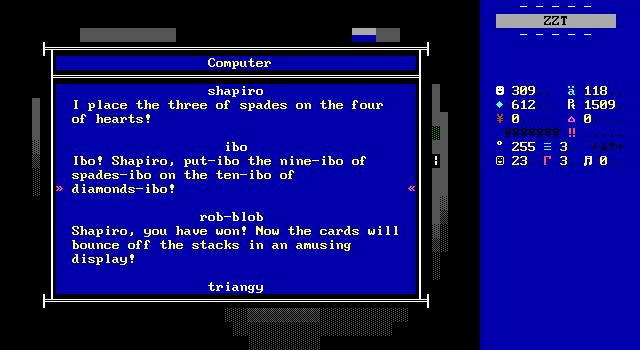
But that doesn't change the fact that I am now quite grateful that I played Gem Hunter 3 and the first Asbestos before Year of Shapiro. Knowing this was out there, would have only made my frustrations with these non-Eura titles more pronounced, thanks to this game being such a clear example of the same concept done better in pretty much every way.
For the first one or two entries in the compilation, Eurakarte sets the bar very high for Year of Shapiro. These two did wind up being the stars of the pack for me, though what remains is rather solid as well. Going from great to good ain't a sin.
Mr. Shapiro Cares Not For Action
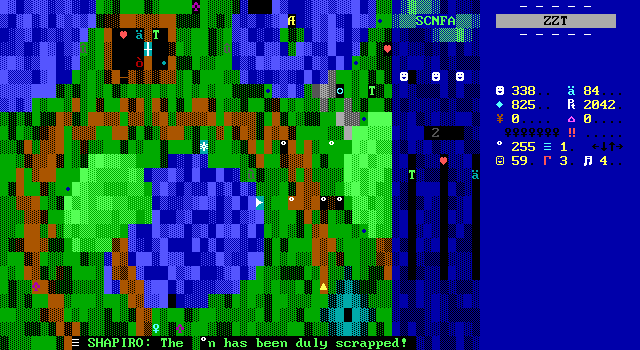
After showing off everything in the canceled Lies 2, Eurakarte's next game is a six level score chasing game that uses an engine rather than rely on the player. Each board is a level where Shapiro has to grab as many items as he can to boost his score on his way to its exit. For obstacles, enemies shoot at him, and more importantly there's a time limit that forces players to keep moving setting the tempo of the game at a rather frantic pace.
Shapiro has his own health and ammo meters to give him some offense and defense. Items can be found to replenish these, with the gameplay mostly being about finding an optimal route to grab all the loot and have enough time to reach the exit.
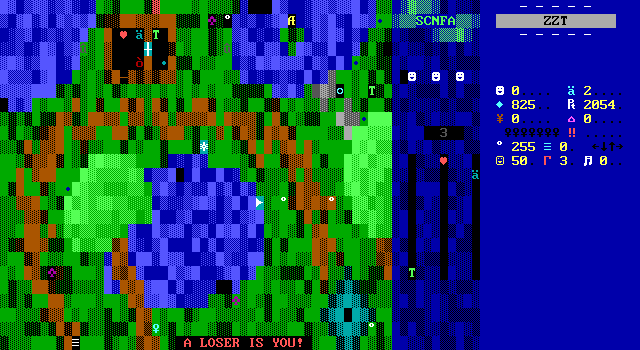
Run out of time, and it's a hard game over.
Nothing Shapiro does in this engine can't already be done with the actual player. Creating a bespoke engine to crudely create ZZT functions within ZZT is generally a bad move. (Just ask 13-year old me.) There really aren't any advantages to using an object steered by the player for a run-and-gun game other than being able to alter the player's appearance. Getting to actually move a yellow triangle for Shapiro is a nice touch, but it comes with some hefty trade-offs that have the potential to sink any game that dares to design its own player.
The immediately obvious is that objects can't touch other objects. To get around this, every time players try to move Shapiro in a direction they're blocked in, a message is sent to all collectible objects on the board to see if they're blocked in the opposite direction Shapiro tried to move in. This works well enough whenever Shapiro is actually trying to grab something. However, objects can't tell what is blocking them, making the system prone to false-positives. Although Eurakarte mitigates this by keeping enemies out of the way of items, it's not enough to eliminate the problem. Players can take advantage of this by shooting bullets adjacent to items and timing their own movement when against a wall to grab them from a distance. Sometimes the enemies bullets will cause players to phantom-grab and item unintentionally as well.
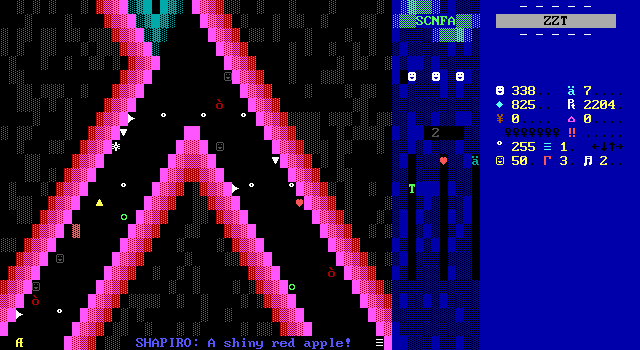
Positioning mostly mitigates this, and while there are some items that Shapiro wants to avoid grabbing a phantom-grab could be pretty annoying. I don't think any of these grabs happened to me that weren't positive, thanks to Karte's item and enemy placement, but the need for that specific positioning means Karte has to design levels in such a way that he wouldn't if he was just using the actual player instead.
Use of an object for the player means that the enemies themselves also have to be fairly simple as well. Without access to #GO SEEK (as it will only track the actual player), enemies are forced to guess where players are. They're stuck moving randomly, in fixed patterns, or not at all, and just firing blindly and hoping to strike Shapiro.
Once again though, Eurakarte is able to design around the flaws in a way that make this game another hit rather than the expected miss.
Most of this boils down to the very tight time limit in play. Players have very little time to reach the exit if they also want to try and grab the treasures. The enemies normally wouldn't be much of a threat, but they do add a bit of unpredictability. If you're trying to collect everything, most levels will take a few tries, with the enemy randomness preventing things from playing out exactly the same way and requiring players to adapt each attempt.
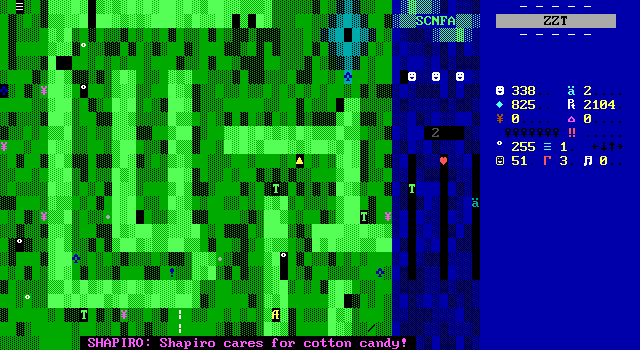
The levels themselves also have some love put into them. Each one looks completely different from the others with Shapiro covering expected environments like plains, caves, and icy lakes, as well as a few more abstract levels built around more enclosed spaces where the enemies are close enough to really be threatening.
Each level contains different items to grab for points, with Shapiro commentating on them a bit as opposed to merely saying what you grabbed and how many points it was worth. The game is still able to keep that Shapiro vibe going despite being devoid of any of the usual characters. Bonus items include the series staple of Erm-Fruit as well as other treats including cotton candy, tomatoes, and "the solid form of H2O in a cube".
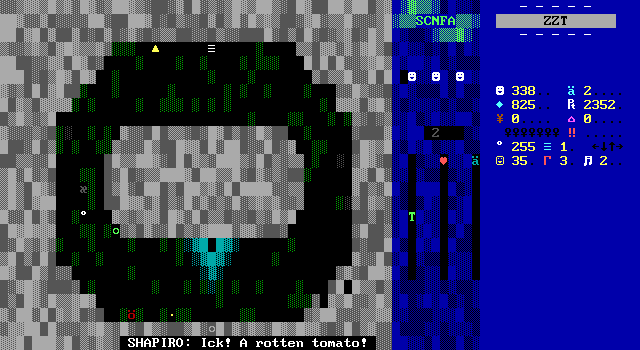
There are also penalizing items that reduce your score, which I would love to say only matter the first time you grab one and learn that it's not safe to touch, but with the frantic pace, I definitely found myself grabbing more of these items than I should have been. At least... I hope it's because of the frantic pace.
*Cough*
These items to miss include Kabadbot fruit, CDs of Christian hymns, rotten tomatoes, and of course yellow snow.
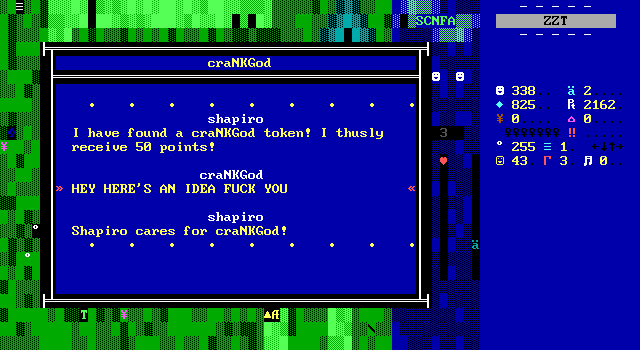
There is one special item to grab on each level, that also doubles as the game's only other speaking character. The character is a cameo of CraNKGod. Crank is not happy to here, and with each passing level his complaints get more and more extreme, which is genuinely a really good motivation to get players to want to grab CraNKGod on every level they can. It's not a Shapiro game if you aren't laughing.
The time limit is just the start of the difficulty in grabbing CraNKGod. He's is often placed in areas that can't be accessed right away. Switches and extra keys are used to make the highlight of each stage that much more difficult to reach.
It was compelling to play through, if a bit same-y by the end of it. At six levels, there's enough here for me to be fairly confident that Eurakarte was on to something with this game's design. The issues with using an object rather than the player don't impede things all that much, making the biggest flaw just the lack of new things to do in each level.
I suspect stretching this out into a full game without adding anything else to mix up the formula a bit might get a bit tiring. The lack of any story and the limited dialog hold Shapiro back from its trademark humor, resulting in a game that's a little bit too purely action focused. As a little treat after some more slowly paced adventures seen previously though, this is a nice respite from the more traditional adventures that preceded and will follow Mr. Shapiro Cares Not For Action in this compilation.
Shapiro Pynball
Oh! Hello dave2!
Turns out this compilation isn't entirely Eurakarte's doing. Dave2 provides a Mr. Shapiro themed Pynball table. Pinball in ZZT is about as difficult as you'd expect given that the engine doesn't officially support any non-orthogonal movement without the use of external editors, and even then is limited to a whopping eight directions of movement.
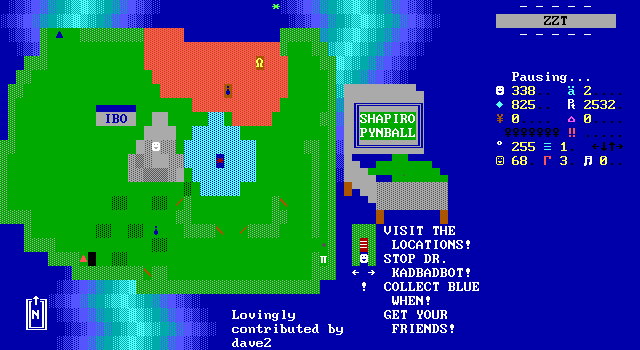
Not that that stopped dave2 from trying. With respect to ZZT's limitations, this is about as pinball as it gets. I confess, it doesn't really click with me these days, though I remember enjoying it as a kid. The timing is very tight given that the flippers are just single characters, and the limited angles make the ball's movement feel unnatural and hard to predict.
I did not play for very long before running out of balls and getting a game over.
For the Shapiro theme, the marketing blurb on the side of the board pretty much covers it. You can bounce the ball off Blue When brand sauce, find and recruit Shapiro's friends into your group, visit Ibo's lab, rescue Shapiroette from Dr. Kabadbot. All of these are fitting enough, they just all trigger when you bump the right spot. All of this at least suggests a more complex table design than hitting bumpers for points until you drop the ball, yet isn't so developed as to count as a progression system.
It remains a cute addition, and the fact that Karte was able to get somebody to contribute something original to include speaks to the success of Shapiro within the community (or at least winning over dave2). This isn't likely to hold your interest for any longer than three quick balls even if it's designed to be a high score chasing game.
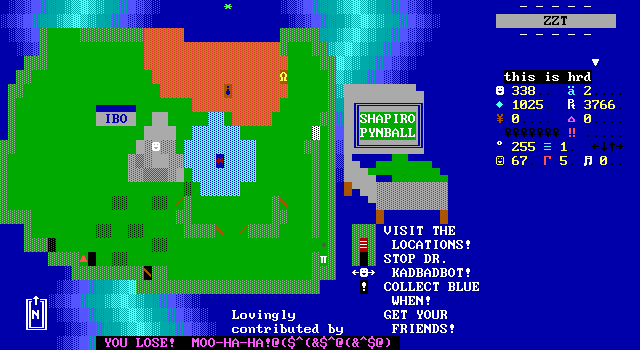
Which is also the source of my one nitpick for the game. When all three balls are gone, you get a game over. You need the game to end to be able to submit a high score, (although none of the player's various counters are reset upon completing a game, so it's easy to enter the board with points already). With how brief it's likely to be, I'd have been quite happy to just have an exit open up and get to leave instead of having to quit out. The engine could also have been implemented in a way to permit resets without reloads easily enough. Perhaps a prompt asking you to play again, quit playing, or end the game to submit a high score.
It's silly to get too worked up about. I had no complaints with game overs anywhere else. It's really just that here the death isn't tied to the player losing health. When you die in the forests, of course you die in real life. When you die in the pinball table, that seems a bit overkill.
Okay. Goodbye dave2.
Shapiro Chopper Command
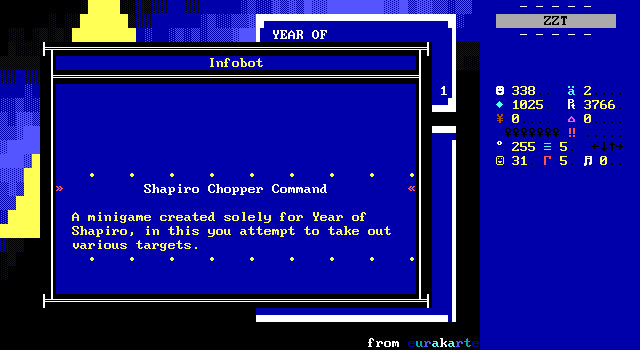
Eurakarte also wanted to contribute something to his own compilation. Something that would be fresh and new rather than an incomplete or rushed project. A nice idea. The scrapped material means most of Year of Shapiro is going to be new to players at least. Later on though, anybody who was following 24 Hours of ZZT competitions is only going to see games they've come across before. This means at least one game ticks both the "new" and "complete" check boxes.
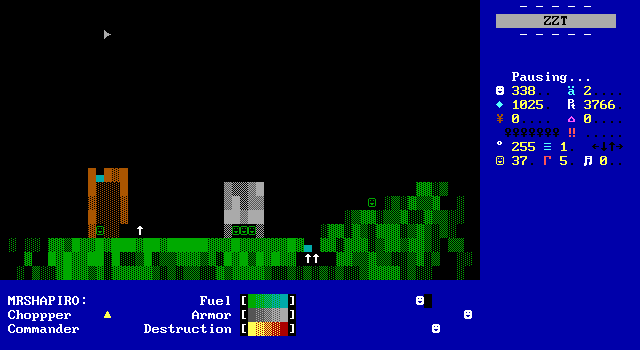
But oof. Pynball may not have done anything for me, but Shapiro Chopper Command is undoubtedly the weakest part of this pack. It's not fun to play, not fun to look at, and doesn't even seem to have anything to do with Shapiro. It's a complete miss all around.
Just as with Pynball and Action, players are dropped right in with no instructions on how to play. The other games get away with it by just replicating ZZT and replicating pinball, not exactly unfamiliar styles of gameplay. Chopper Command still looks familiar enough, but there's a lot of questions players have to find the answers to on the fly.
Shapiro is now piloting a helicopter above some military facility? I really don't know. Your mission is to bomb some structures and soldiers before running out of fuel or being shot down by anti-aircraft fire. Even that's a generous interpretation. The enemies are dark green and unnamed mooks, internal named "RandomMan" which is hardly a good sign for the amount of thought that went into this one.
Conceptually the gameplay is feasible. Unfortunately in practice, piloting Shapiro's chopper isn't all that fun. Having the vehicle in question be a helicopter means you still move around just as you would the player, though a row of invisible water prevents descending below an arbitrary threshold. Being this far away from the ground means you have ages to react to enemy fire and have to wait quite awhile for your own shots to chip away at buildings. Bombs these ain't.
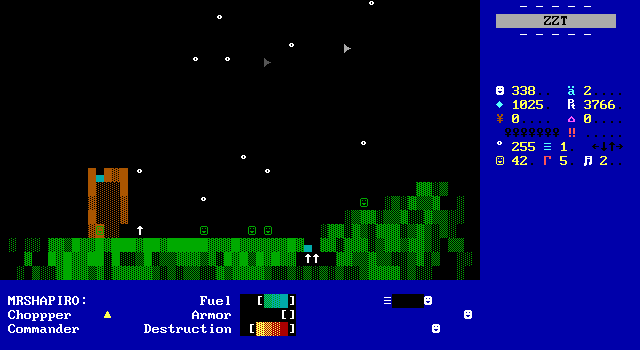
It's not entirely devoid of charm, even if there is no connection to Shapiro beyond him being the pilot. It is possible to actually blow up buildings once they're sufficiently damaged by hitting specific tiles. These cause bits of the wall to launch up and outward, doing a much better job of communicating destruction than these kinds of engines usually get.
Players also can't focus entirely on what's below them. A duplicator on the side spawns in enemy planes that zip across the screen shooting bullets at your chopper. This is a neat little idea that forces players to evade and presents the possibility of dodging away from horizontal-bullets and into the path of a vertical one.
It plays very slowly. There's only a single level as well so what you see here is all you get. The game has no replayability like getting a high score in Pynball. It's just over and done with in a minute or two, leaving me wondering why Karte bothered. If the fuel or armor meters empty out, you lose. If the destruction meter empties, you win.
This is the sort of engine you might see show up as part of a larger game. A few years down the line, Quantum P. would include a bombing run in part four of Operation: GAMMA VELORUM. Here players would get a fancier engine, that feels like it matters as there's an overarching plot necessitating this bombing to begin with. Agent Orange's comparatively recent release of 587 Squadron uses an overhead view and bomber that always moves forward to create a game that feels like skill is necessary to pilot your way to victory. Eurakarte's game seems like something you'd have seen as a one-off submission to the ZZT encyclopedia, more interest in proving an engine can be done than in proving an engine can be fun.
Playing this entirely standalone, with no greater context just makes for a very quickly forgotten experience. I really don't understand the lack of themeing here. Shapiro is a comical character, yet there's no attempt at humor here. Why doesn't blowing up a building launch Dr. Kabadbot into the stratosphere? Why is Shapiro piloting a helicopter instead of flying around and attacking with his eye lasers in a completely absurd manner? Heck, the 24 Hours of ZZT entries introduce him having an "air-jeep". It's the absurdity that makes Shapiro Shapiro, and this is just a generic ZZT military shooter that's so generic that the only reason I'm calling it "military" is because the enemies are dark green.


